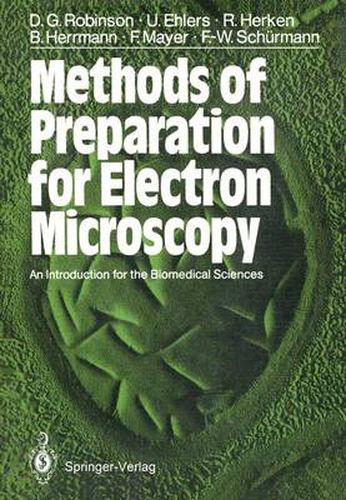Readings Newsletter
Become a Readings Member to make your shopping experience even easier.
Sign in or sign up for free!
You’re not far away from qualifying for FREE standard shipping within Australia
You’ve qualified for FREE standard shipping within Australia
The cart is loading…






This title is printed to order. This book may have been self-published. If so, we cannot guarantee the quality of the content. In the main most books will have gone through the editing process however some may not. We therefore suggest that you be aware of this before ordering this book. If in doubt check either the author or publisher’s details as we are unable to accept any returns unless they are faulty. Please contact us if you have any questions.
In 1939, when the electron optics laboratory of Siemens & Halske Inc. began to manufacture the first electron microscopes, the biological and medical profes sions had an unexpected instrument at their disposal which exceeded the reso lution of the light microscope by more than a hundredfold. The immediate and broad application of this new tool was complicated by the overwhelming prob lems inherent in specimen preparation for the investigation of cellular struc tures. The microtechniques applied in light microscopy were no longer appli cable, since even the thinnest paraffin layers could not be penetrated by electrons. Many competent biological and medical research workers expressed their anxiety that objects in high vacuum would be modified due to complete dehydration and the absorbed electron energy would eventually cause degrada tion to rudimentary carbon backbones. It also seemed questionable as to whether it would be possible to prepare thin sections of approximately 0. 5 11m from heterogeneous biological specimens. Thus one was suddenly in posses sion of a completely unique instrument which, when compared with the light microscope, allowed a 10-100-fold higher resolution, yet a suitable preparation methodology was lacking. This sceptical attitude towards the application of electron microscopy in bi ology and medicine was supported simultaneously by the general opinion of colloid chemists, who postulated that in the submicroscopic region of living structures no stable building blocks existed which could be revealed with this apparatus.
$9.00 standard shipping within Australia
FREE standard shipping within Australia for orders over $100.00
Express & International shipping calculated at checkout
This title is printed to order. This book may have been self-published. If so, we cannot guarantee the quality of the content. In the main most books will have gone through the editing process however some may not. We therefore suggest that you be aware of this before ordering this book. If in doubt check either the author or publisher’s details as we are unable to accept any returns unless they are faulty. Please contact us if you have any questions.
In 1939, when the electron optics laboratory of Siemens & Halske Inc. began to manufacture the first electron microscopes, the biological and medical profes sions had an unexpected instrument at their disposal which exceeded the reso lution of the light microscope by more than a hundredfold. The immediate and broad application of this new tool was complicated by the overwhelming prob lems inherent in specimen preparation for the investigation of cellular struc tures. The microtechniques applied in light microscopy were no longer appli cable, since even the thinnest paraffin layers could not be penetrated by electrons. Many competent biological and medical research workers expressed their anxiety that objects in high vacuum would be modified due to complete dehydration and the absorbed electron energy would eventually cause degrada tion to rudimentary carbon backbones. It also seemed questionable as to whether it would be possible to prepare thin sections of approximately 0. 5 11m from heterogeneous biological specimens. Thus one was suddenly in posses sion of a completely unique instrument which, when compared with the light microscope, allowed a 10-100-fold higher resolution, yet a suitable preparation methodology was lacking. This sceptical attitude towards the application of electron microscopy in bi ology and medicine was supported simultaneously by the general opinion of colloid chemists, who postulated that in the submicroscopic region of living structures no stable building blocks existed which could be revealed with this apparatus.